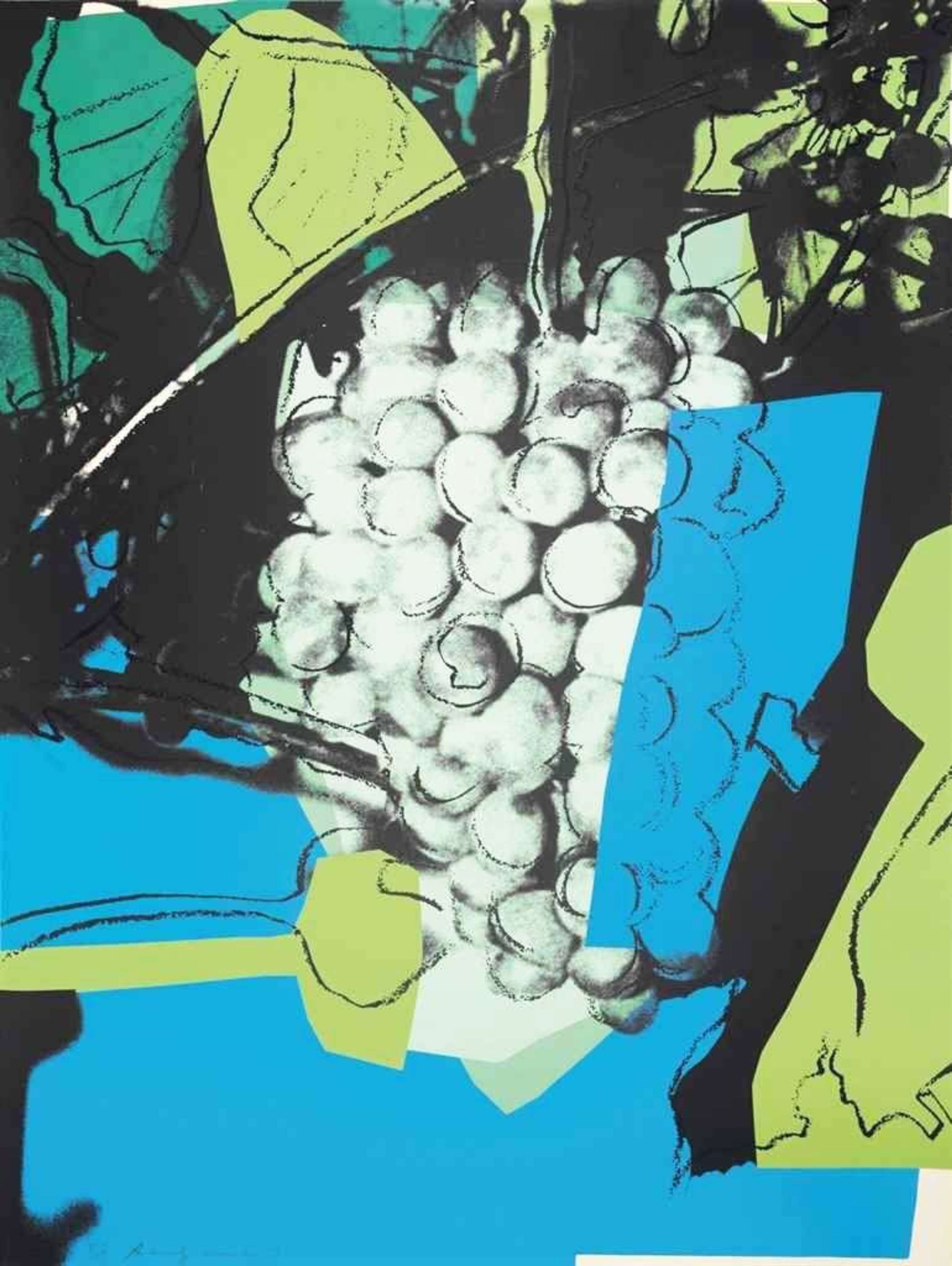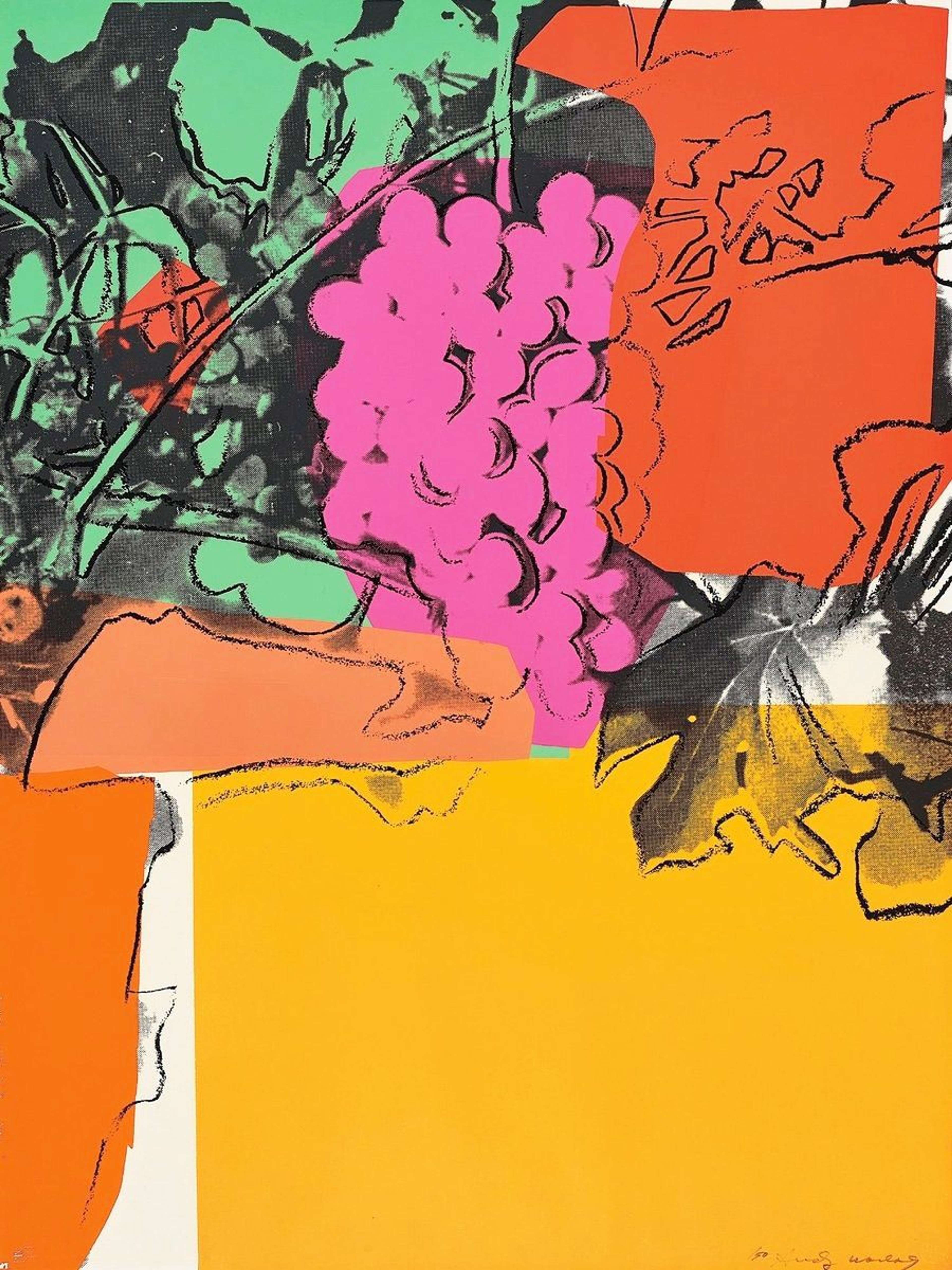 Grapes (complete set) © Andy Warhol 1979
Grapes (complete set) © Andy Warhol 1979
Interested in buying or selling
Andy Warhol?

Andy Warhol
487 works
Created in 1979, the Grapes print series is Andy Warhol's vibrant foray into the still life genre. Created in his signature Pop Art style, the series is an experimental and toys with tradition.
Warhol took a unique approach to the still life genre in this series.
 Grapes (F. & S. II.191) © Andy Warhol 1979
Grapes (F. & S. II.191) © Andy Warhol 1979Though the still life genre, in Western art, is characterised by a pursuit of realism, Warhol's still lifes are treated almost like abstractions. Through his typical layering of vibrant inks, and graphic outlining by hand, Warhol's Grapes toy with realism. Like his earlier works that focused on consumable products, as with his Campbell's Soup and Brillo Box series, Warhol treats the organic grape bunch as a static object.
This series was the first time Warhol experimented with diamond dust.
 Diamond Dust Shoes (F. & S. II.254) © Andy Warhol 1980
Diamond Dust Shoes (F. & S. II.254) © Andy Warhol 1980This still life series is historically significant in Warhol's oeuvre, as it was the first time that the artist experimented with diamond dust. Through his application of real diamond dust particles on the surface of his prints, Warhol added a luxe materiality to his screen prints. A close friend of Warhol's, John Reinhold, said of Warhol's use of diamond dust: “I gave him the first jar of diamond dust. Real diamond dust doesn’t sparkle but he played with it. I think what he in fact used is crushed glass. It didn’t work with real diamonds but that’s when he started to think about the idea.” After the Grapes series, Warhol continued to use diamond dust in other notable portfolios like Diamond Dust Shoes.
Warhol created two portfolios for Grapes.
 Grapes (F. & S. II.194) © Andy Warhol 1979
Grapes (F. & S. II.194) © Andy Warhol 1979Warhol was clearly fascinated with this still life subject, as he created two Grapes portfolios, each consisting of six screen prints. One series was from a print run of 50, and the other special edition from a small print run of 10 limited edition multiples. In each of these series Warhol created a printer's proof, which were prototypes for the entire series.
The colour palette of the series recalls 1975 Warhol's Mouton Rothschild label.
 Life Savers (F. & S. II.353) © Andy Warhol 1985
Life Savers (F. & S. II.353) © Andy Warhol 1985Warhol's early work is underscored by a fascination with consumerism, elevating the foodstuffs of supermarket shelves to ”fine art”. In 1975, Warhol created a label for Château Mouton Rothschild wine, bringing his artwork to a physical consumable product. The label featured two portraits of Baron Philippe Rothschild, outlined before collaged blocks of colour. In his subsequent Grapes series, Warhol turned to the same colour palette - creating a playful (although coincidental) connection between the wine bottle and the grapes used to make it.
The series draws on collage techniques.
 Grapes (F. & S. II.193) © Andy Warhol 1979
Grapes (F. & S. II.193) © Andy Warhol 1979By overlaying blocks of coloured ink, Warhol's Grapes prints recall the tradition of collage in art history. In many prints from this series, as we see here in Grapes (F. & S. II.193), these colour blocks spliced the bunch of grapes at the centre of the composition. With these collage elements, Warhol disrupted the natural appearance of the grapes, reducing them to two-dimensional objects.
Grapes are symbolic of abundance and merriment.
 Grapes (F. & S. II.192) © Andy Warhol 1979
Grapes (F. & S. II.192) © Andy Warhol 1979Throughout history, grapes have been regarded as a symbol of joy and natural abundance. In Christianity, they represent the blood of Jesus, and are one of the most enduring symbols in Western culture. In this print series, Warhol offered his unique interpretation of Grapes, leaving the viewer to interpret their meaning.
Warhol was fascinated with food.
 After The Party (F. & S. II.183) © Andy Warhol 1979
After The Party (F. & S. II.183) © Andy Warhol 1979From Coca-Cola to fine wine bottles, Warhol had an enduring preoccupation with food and drink, and the way it was marketed to consumers. As we see in his After The Party series, food also played a crucial part in Warhol's own extravagant lifestyle. Given the importance of grapes in producing wine, it is hardly surprising that Warhol should treat this subject with particular consideration.
This series wasn't the first time Warhol depicted grapes.
 In The Bottom Of My Garden 7 (F. & S. IV.91) © Andy Warhol 1956
In The Bottom Of My Garden 7 (F. & S. IV.91) © Andy Warhol 1956Much earlier in his artistic career, Warhol turned to the subject of grapes in his lithograph series In The Bottom Of My Garden. In this 1956 book of prints, Warhol imagined whimsical cherubs and fairies living amongst the flora and fauna of his garden - including grapes.
Grapes are an enduring symbol in art history.
 Grapes (F. & S. II.190) © Andy Warhol 1979
Grapes (F. & S. II.190) © Andy Warhol 1979Throughout the history of art, grapes have been used a symbol across many genres. In traditional still life paintings, grapes and other perishable foods represented the inevitability of time. Likewise, grapes were often used as a symbol for Bacchus, the Greek god of wine and vegetation.
Warhol's Grapes appear devoid of life.
 Grapes (F. & S. II.195) © Andy Warhol 1979
Grapes (F. & S. II.195) © Andy Warhol 1979Despite his use of bold and vibrant colour, the bunch of grapes in each of these prints seems almost unnatural. The bunch of grapes itself is printed in black, as we see in Grapes (F. & S. II.195), and has an artificial quality. Of course, this idea is not limited to this series, as we see in Warhol's celebrity portraits - like Marilyn Monroe and Liz Taylor.
